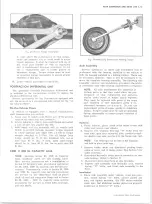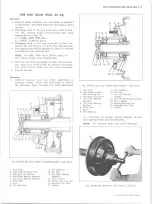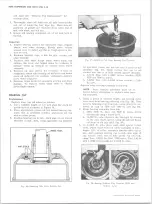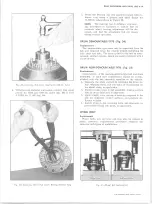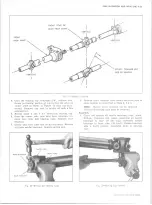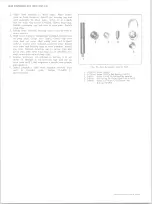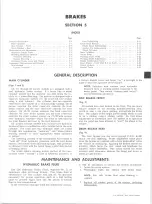
BRAKES
SECTION 5
INDEX
Page
G e n e ra l D e s c r i p t i o n .................. ...
. ...............................
D isc B rake s - F r o n t .......................................................... ...
D r u m B ra k e s - R e a r ................................................. .....................
M ainte nance and A d ju s t m e n t .............................................................
H y d ra u lic B rake F l u i d ....................................................................
B leeding H y d rau lic S y s t e m ....................................................... ...
P re s s u re B l e e d i n g ..................................... ...........................
M anu al B le e d in g ............................................................................
H y d ra u lic B ra k e L in e s and T u b i n g ........................................ ...
Com ponent R e p la c e m e n t and R e p a i r ..............................................
Page
B rake D r u m R e f in is h in g ............................................................. 5-15
M ain C y lin d e r .................................................
................................. 5-16
B rake P e d a l .........................................................................................5-20
P a rk in g B rake P e d a l ...................................................................... 5-22
P a rk in g B rake A d ju s tm e n t............................................................. 5-22
B rake C o m b in atio n V alve ............................... .. ............................. 5-25
R e a r B ra ke s - U sed W ith R .P .O . H - 2 2 .....................................5-26
P o w e r B ra k e s ........................................................................................ 5-29
Special T o o l s ............................................................................ ........... 5-30
GENERAL DESCRIPTION
M A IN CYLINDER
(Figs. 1 and 2)
All 10 through 30 series models are equipped with a
dual hydraulic brake system. If a brake line or wheel
cylinder should fail the operator can still bring the ve
hicle to a controlled stop. The system is designed with a
separate hydraulic system for the front and rear brakes
using a dual cylinder. The cylinder has two separate
reservoirs and outlets in a common body casting. On 10
series vehicles the front reservoir controls the front
brake system and the rear reservoir controls the rear
system. On 20-30 series vehicles the front reservoir
controls the rear brake system and the rear reservoir
controls the front system (except on CA 30 with vacuum
over hydraulic boosters where the front is controlled by
the front booster and rear by the rear booster).
All models (except models with vacuum over hydraulic
boosters) have a combination valve located below the main
cylinder. The front and rear hydraulic lines are routed
through this combination “ metering" and "brake failure
warning switch'' to their appropriate wheel cylinders
or caliper.
The metering portion of the combination valve tends to
"hold off” front hydraulic pressure until the rear brake
system overcomes their pull back springs; then pressure
is allowed to flow with the result being a good distribution
of braking effort.
The brake failure warning switch portion of the com
bination valve "senses” a loss of hydraulic pressure, if
a failure should occur and turns "on” a red light in the
dash to warn the operator of the failure.
NOTE:
Vehicles with vacuum over hydraulic
boosters have a warning switch connected to the
brake pedal. This switch "senses pedal travel”
and not hydraulic pressure.
DISC BRAKES FRONT
(Fig. 3)
All models have disc brakes on the front. The one piece
caliper mounts on the steering knuckle/steering arm,
which is also a one piece casting, and astride the brake
disc. The caliper is the single piston design which is said
to be a sliding caliper sliding piston. No front brake
adjustment is necessary once the system is in operation
and the pedal has been stroked to "seat” the shoes to the
caliper.
DRUM BRAKES REAR
(Fig. 4)
The rear brakes are duo servo (except R.P.O. H-22)
which are self adjusting. Brake adjustment takes place
when the brakes are applied with a firm pedal effort while
the vehicle is backing up. Applying the brakes moves the
actuator which turns the star wheel and lengthens the
adjuster screw assembly. This action moves the shoes
outward until clearance between the lining and drum is
within proper limits.
M AIN TENANCE A N D ADJUSTMENTS
HYDRAULIC BRAKE FLUID
Use GM Hydraulic Brake Fluid, Supreme No. 11 or
equivalent when servicing brakes. This brake fluid is
satisfactory for any climate and has all the qualities
necessary for proper operation, such as a high boiling
point to prevent vapor lock and the ability to remain
fluid at low temperatures.
In the event that improper fluid has entered the system,
it will be necessary to service the system as follows:
1. Drain the entire system.
2. Thoroughly flush the system with brake fluid.
NOTE:
Use only brake fluid when flushing a
system.
3. Replace all rubber parts of the system, including
brake hoses.
10-30 CHEVROLET TRUCK SERVICE MANUAL
Summary of Contents for 10 1971 Series
Page 1: ......
Page 96: ......
Page 100: ...10 30 CHEVROLET TRUCK SERVICE MANUAL Fig 4 10 30 Series Truck Frame FRAME 2 4 ...
Page 120: ......
Page 203: ...ENGINE 6 25 Fig 22L Engine Mounts 10 30 CHEVROLET TRUCK SERVICE MANUAL ...
Page 215: ...ENGINE 6 37 REAR M O U NT Fig 21V Engine Mounts 10 30 CHEVROLET TRUCK SERVICE MANUAL ...
Page 218: ......
Page 249: ......
Page 324: ......
Page 340: ......
Page 365: ...10 30 CHEVROLET TRUCK SERVICE MANUAL Fig 43 Power Steering Pump M ounting STEERING 9 25 ...
Page 368: ......
Page 386: ......
Page 390: ...ELECTRICAL BODY AND CHASSIS 12 4 10 30 CHEVROLET TRUCK SERVICE MANUAL ...
Page 391: ......
Page 428: ......
Page 432: ......
Page 449: ...SPECIFICATIONS 9 10 30 CHEVROLET TRUCK SERVICE MANUAL ...
Page 463: ......
Page 464: ......
Page 465: ......
Page 466: ......

